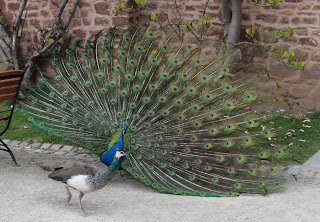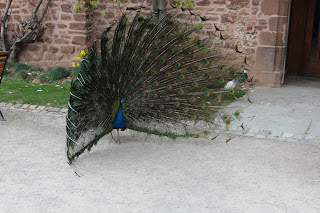The scientist and writer Isaac Asimov told the story of a long sea voyage during which a fellow passenger, a Mr Jones, became terribly seasick. On one occasion, as he was feeling particularly green and poorly in a corner of the lounge, one of the ship’s stewards came up to him, laid a hand kindly on his shoulder, and said, “I know you’re feeling really awful, sir, but don’t worry - no-one ever died of seasickness.” To which Mr Jones replied, “Oh no, please don’t say that! It’s only the blessed hope of dying that’s keeping me alive!”
Most of the really good resurrection stories are to be found in St John’s Gospel, but here today is the exception that proves that rule, the lovely story told by Luke of the two disciples on the road to Emmaus, and their encounter with Jesus. They may not have been quite as low and desperate as Mr Jones, but they were pretty downhearted. They may not have hoped for death, but they were resigned to it - not looking forward to much else.
How well they knew Jesus we don’t know, but they seem to have been on pretty good terms with Peter and the others, so it’s a fair assumption that they should have been able to recognise him. So why didn’t they, when he joined them on the road? One writer suggests that, walking due west toward the end of the day (as they were), maybe the sun was in their eyes; but I think there’s more to it than that. This not recognising Jesus is something that turns up again and again as we read the Easter Gospels.
We’ll come back to that, though. For now, let’s reflect on the fact that it’s while they were talking about him that Jesus came up and joined them. While they were talking about him. Do we talk enough about Jesus? To one another, and to others? It does seem to me that the more we talk about him, the more he figures in our lives, the more likely he is to meet with us on the road. “I stand at the door and knock,” says Jesus in the Book of Revelation. But if we’re not talking about him, if he’s not in the forefront of our minds, then maybe we won’t hear that knock.
And when he did meet with them, what did he do? He explained things, he opened their minds to the truth. To the extent that their hearts burned within them, as they say later on. To be honest, you’d have thought they would have recognised him by this stage. Who else did they know who could expound God’s word with such freshness, such vision, such energy? Remember what people had said of him, back in Galilee? “He teaches in a new way, not like the teaching of the scribes and the Pharisees.”
But anyway, they still didn’t recognise him. It’s almost as if he’s playing with them, in a gentle way, testing them as well as teaching them, rebuking them for their slowness as well as opening their minds. This not recognising Jesus, then. I think the Gospel writers want us to understand that there is something fundamentally different about Jesus now. He hasn’t returned to his old life, he hasn’t somehow escaped from death. Easter begins something new, not an escape from the inevitable, but its defeat. And yet he is the same man, recognised not from his face but from the scars he bears, or recognised (as we shall see) in the things he does.
But I think as well that none of us is very good at processing the unexpected. We form our picture, our theory of how the world works, of how the world should be, and things that don’t fit in with that get set aside, dismissed, maybe just not noticed at all. I cam across someone I know the other day, but not in a place either of us would visit very often. She was coming straight towards me along the street; I smiled, waved, said “Good morning!” - and she just walked straight past. A few steps further on, she stopped, turned, came back and said, “Oh! sorry! I didn’t expect to see you here!” What we don’t expect to see, we don’t see, or at least, not straight away. So do we expect to see Jesus? Or maybe I should ask, WHERE do we expect to see Jesus? In the everyday business of our everyday lives? In our work, in our friendships? Be sure, he is there, but maybe if we don’t expect to find him, we won’t be aware.
Perhaps we reserve Jesus to a place like this, with stone walls and pointy windows, and are not aware of him, not able to recognise him, anywhere else. Here’s a challenge for all of us, one that frankly I don’t manage to face up to all the time, but we should all be trying our best: to place Jesus at the centre, to see if we can recognise him in all kinds of unexpected places, in secular places as well as in the ones that are labelled and identified as holy. It’s the difference between religion being one of our hobbies or pastimes among others, and religion - or let’s say faith, it’s a better word - faith being the reason why we do all the other stuff.
The two disciples said to the man who had joined them, who as yet they hadn’t recognised, “Where have you been all this time? Everybody’s talking about what happened to Jesus of Nazareth. We had thought he was the one to save us, to set us free, but then it all went wrong, it all fell apart.” That was their assessment, the picture, the world view, by which they were living, that controlled how they saw things. So the man explained things to them, pointed them round towards a different way of seeing things - but still they didn’t recognise him.
Two things that changed things: something they did, something he did. They invited him in. “Don’t go on, far too late in the day, we’ve got room, stay here.” Basic hospitality, something very much prized in the Middle East, but there’s a simple and basic message in this story, that acts of kindness can often bring unexpected blessings. And the simple fact that we’re all moved by them must say something about how we should be, who we’re really programmed to be, with one another. The film of the runner last Sunday helping his fellow runner who could hardly stand get to the line and over it at the London Marathon has gone viral.
Then there’s what Jesus does: he breaks the bread, and their eyes are opened. He breaks the bread. Here at this table we are most specially aware of him, most specially able to receive from him, here we are received, blessed, equipped, fed - and sent out.
There are disclosure moments in life; sometimes people call them religious experiences. Moments when the world seems sharper, more focused, when we see more clearly, when we fell more deeply, moments when the penny drops, when we understand, when we see. It’s interesting, isn’t it, that we use the same word “see” about both vision and understanding. In the resurrection stories, people failed to recognise Jesus because they hadn’t yet seen, understood, what had really happened. Every Eucharist should be a disclosure moment, for we’re not here just to remember, to look back, to hold a memorial service; no, the Greek word anamnesis which we translate as “remembrance” - do this in remembrance of me - actually means something much stronger, it’s about being in the presence of our Lord, being part of the supper he gives, in which he continues to be here among us, breaking the bread, here and now. Our risen Lord.
Our risen Lord, who assures us now as he told those disciples then, that love is come again, like wheat that springeth green - that love is victorious, is always victorious, is finally and completely victorious, over all that can enslave us, all that ties us down. The two disciples set out straight away, back to Jerusalem, to share the good news. That’s what happens when the penny drops, and when, instead of being resigned to death, we have seen what it means to live.






